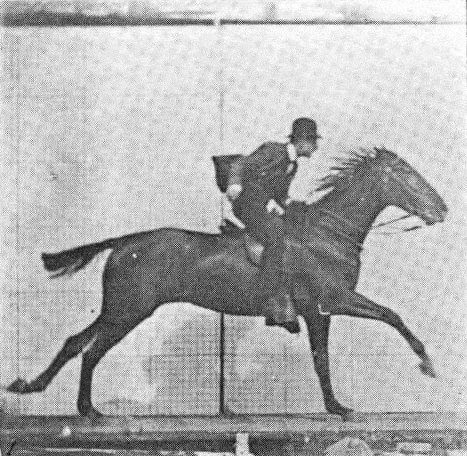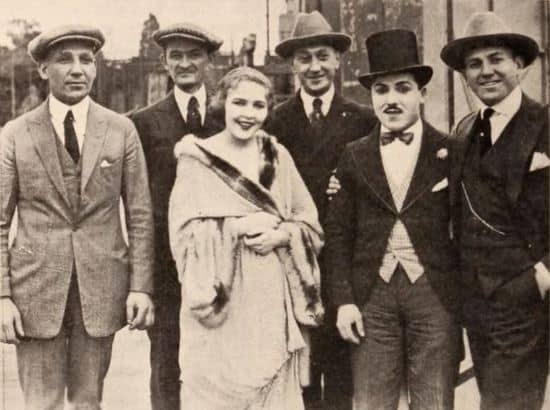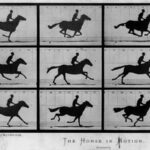Hollywood: Perhaps no other place on earth evokes the same air of show-business magic and glamour. The legend of Hollywood began in the early 20th century and is an earmark of modern American society rich in history and innovation.
The Origin of Movies

The origin of movies and motion pictures began in the late 1800’s, with the invention of “motion toys” designed to trick the eye into seeing an illusion of motion from a display of still frames in quick succession, such as the thaumatrope and the zoetrope.
The First Movie

In 1872, Edward Muybridge created the first movie ever made by placing twelve cameras on a racetrack and rigging the cameras to capture shots in quick sequence as a horse crossed in front of their lenses.
Recommended Reading
The History of Hollywood: The Film Industry Exposed
First Movie Ever Made: The Early History of Film
Christmas Trees, A History
The first film for motion photography was invented in 1885 by George Eastman and William H. Walker, which contributed to the advance of motion photography. Shortly thereafter, the brothers Auguste and Louis Lumiere created a hand-cranked machine called the cinematographe, which could both capture pictures and project still frames in quick succession.
1900s Movies
The 1900’s were a time of great advancement for film and motion picture technology. Exploration into editing, backdrops, and visual flow motivated aspiring filmmakers to push into new creative territory. One of the earliest and most famous movies created during this time was The Great Train Robbery, created in 1903 by Edwin S. Porter.
Around 1905, “Nickelodeons”, or 5-cent movie theaters, began to offer an easy and inexpensive way for the public to watch movies. Nickelodeons helped the movie industry move into the 1920’s by increasing the public appeal of film and generate more money for filmmakers, alongside the widespread use of theaters to screen World War I propaganda.
The end of World War I ushered the United States into a cultural boom, a new industry center was on the rise: Hollywood, the home of motion pictures in America.
1910s Hollywood
According to industry myth, the first movie made in Hollywood was Cecil B. DeMille’s The Squaw Man in 1914 when its director decided last-minute to shoot in Los Angeles, but In Old California, an earlier film by DW Griffith had been filmed entirely in the village of Hollywood in 1910.
Notable actors of this period include Charlie Chaplin.
By 1919, “Hollywood” had transformed into the face of American cinema and all the glamour it would come to embody.
1920s Hollywood
The 1920’s were when the movie industry began to truly flourish, along with the birth of the “movie star”. With hundreds of movies being made each year, Hollywood was the rise of an American force.
Hollywood alone was considered a cultural icon set apart from the rest of Los Angeles, emphasizing leisure, luxury, and a growing “party scene”.
This age also saw the rise of two coveted roles in the movie industry: the director and the star.
Directors began to receive greater recognition for using and trademarking personal styles in the creation of their films, which previously in history had not been possible due to limitations in filmmaking technology.
Additionally, movie stars began to receive greater fame and notoriety due to increases in publicity and shifts in American trends to value faces from the big screen.
The United States First Film Studio

The 1920s also saw the founding of the first movie studio in the United States.
On April 4, 1923, four brothers, Harry, Albert, Sam, and Jack Warner used money loaned by Harry’s banker to officially incorporated their company Warner Brothers Pictures.
1930s Hollywood
READ MORE: Harmonizing History: Who Invented Jazz?
The 1930’s was considered the Golden Age of Hollywood, with 65% of the US population attending the cinema on a weekly basis.
A new era in film history began in this decade with the industry-wide movement towards sound into film, creating new genres such as action, musicals, documentaries, social statement films, comedies, westerns, and horror movies, with stars such as Laurence Olivier, Shirley Temple, and director John Ford rising to rapid fame.
The use of audio tracks in motion pictures created a new viewer dynamic and also initiated Hollywood’s leverage in the upcoming World War II.
1940s Hollywood
The early 1940’s were a tough time for the American film industry, especially after the attack on Pearl Harbor by the Japanese. However, production saw a rebound due to advances in technology such as special effects, better sound recording quality, and the beginning of color film use, all of which made movies more modern and appealing.
Like all other American industries, the film industry responded to World War II with increased productivity, creating a new wave of wartime pictures. During the war, Hollywood was a major source of American patriotism by generating propaganda, documentaries, educational pictures, and general awareness of wartime need. The year 1946 saw an all-time high in theater attendance and total profits.
1950s Hollywood
The 1950’s were a time of immense change in American culture and around the world. In the post-war United States, the average family grew in affluence, which created new societal trends, advances in music, and the rise of pop culture – particularly the introduction of television sets. By 1950, an estimated 10 million homes owned a television set.
A shift in demographics created a change in the film industry’s target market, which began creating material aimed at American youth. Instead of traditional, idealized portrayals of characters, filmmakers started creating tales of rebellion and rock n’ roll.
This era saw the rise of films featuring darker plot lines and characters played by “edgier” stars like James Dean, Marlon Brando, Ava Gardner, and Marilyn Monroe.
The appeal and convenience of television caused a major decline in movie theater attendance, which resulted in many Hollywood studios losing money. To adapt to the times, Hollywood began producing film for TV in order to make the money it was losing in movie theaters. This marked the entrance of Hollywood into the television industry.
1960s Hollywood
The 1960’s saw a great push for social change. Movies during this time focused on fun, fashion, rock n’ roll, societal shifts like the civil rights movements, and transitions in cultural values.
It was also a time of change in the world’s perception of America and its culture, largely influenced by the Vietnam War and continuous shifts in governmental power.
1963 was the slowest year in film production; approximately 120 movies were released, which was fewer than any year to date since the 1920’s. This decline in production was caused by lower profits due to the pull of television. Film companies instead began to make money in other areas: music records, movies made for TV, and the invention of the TV series. Additionally, the average film ticket price was lowered to only a dollar, in an attempt to draw more patrons to the cinema.
By 1970, this caused a depression in the film industry that had been developing over the past 25 years. A few studios still struggled to survive and made money in new ways, such as theme parks like Florida’s Disney World. Because of financial struggles, national companies bought out many studios. The Golden Age of Hollywood was over.
1970s Hollywood
With the Vietnam War in full swing, the 1970’s began with an essence of disenchantment and frustration within American culture. Although Hollywood had seen its lowest times, during the late 1960’s, the 1970’s saw a rush of creativity due to changes in restrictions on language, sex, violence, and other strong thematic content. American counterculture inspired Hollywood to take greater risks with new alternative filmmakers.
Latest Entertainment Articles
Who Invented Twerking? The Origins of a Viral Sensation
Who Invented Facebook? The Birth of a Social Media Revolution
The Mastermind Behind Blocks: Who Invented Minecraft Unveiled
The rebirth of Hollywood during the 1970’s was based on making high-action and youth-oriented pictures, usually featuring new and dazzling special effects technology.
Hollywood’s financial trouble was somewhat alleviated with the then-shocking success of movies like Jaws and Star Wars, which became the highest-grossing movies in film history (at that time).
This era also saw the advent of VHS video players, laser disc players, and films on video cassette tapes and discs, which greatly increased profits and revenue for studios. However, this new option to view movies at home once again caused a decrease in theater attendance.
1980s Hollywood
In the 1980’s, the past creativity of the film industry became homogenized and overly marketable. Designed only for audience appeal, most 1980’s feature films were considered generic and few became classics. This decade is recognized as the introduction of high concept films that could be easily described in 25 words or less, which made the movies of this time more marketable, understandable, and culturally accessible.
By the end of the 1980’s, it was generally recognized that films of that time were intended for audiences who sought simple entertainment, as most pictures were unoriginal and formulaic.
Many studios sought to capitalize on advancements in special effects technology, instead of taking risks on experimental or thought-provoking concepts.
The future of film looked precarious as production costs increased and ticket prices continued to drop. But although the outlook was bleak, films such as Return of the Jedi, Terminator, and Batman were met with unexpected success.
Due to the use of special effects, the budget of film production increased and consequently launched the names of many actors into overblown stardom. International big business eventually took financial control over many movies, which allowed foreign interests to own properties in Hollywood. To save money, more and more films started to launch production in overseas locations. Multi-national industry conglomerates bought out many studios, including Columbia and 20th Century Fox.
1990s Hollywood
The economic decline of the early 1990’s caused a major decrease in box office revenue. Overall theater attendance was up due to new multiscreen Cineplex complexes throughout the United States. Use of special effects for violent scenes such as battlefield scenes, car chases, and gunfights in high-budget films (such as Braveheart) was a primary appeal for many moviegoers.
Meanwhile, pressure on studio executives to make ends meet while creating hit movies was on the rise. In Hollywood, movies were becoming exorbitantly expensive to make due to higher costs for movie stars, agency fees, rising production costs, advertising campaigns, and crew threats to strike.
VCR’s were still popular at this time, and profits from video rentals were higher than the sales of movie tickets. In 1992, CD-ROM’s were created. These paved the way for movies on DVD, which hit stores by 1997. DVD’s featured a much better image quality as well as the capacity for interactive content, and videotapes became obsolete a few years later.
2000s Hollywood

The turn of the millennium brought a new age in film history with rapid and remarkable advances in technology. The movie industry has already seen achievements and inventions in the 2000’s, such as the Blu-ray disc and IMAX theaters.
Additionally, movies and TV shows can now be watched on smartphones, tablets, computers, and other personal devices with the advent of streaming services such as Netflix.
Explore More Entertainment Articles
Who Invented Rap? Truth of the Musical Phenomenon
Origins of Lacrosse: Unveiling the History of Lacrosse and Its Native American Roots
History of Cinema in Jamaica
The History of Hollywood: The Film Industry Exposed
Who Invented the Rubik’s Cube? The Real Story of the Brain Box
Who Invented Chess? Story Behind the Royal Game
The 2000’s have been an era of immense change in the movie and technology industries, and more change is sure to come quickly. What new innovations will the future bring us? Only time will tell.
READ MORE: Shirley Temple











Good evening, would you mind to tell me the writer of this article? I’m working on a research on this topic, can you help me. Thanks.
Me too I really need the name of the writer :/
The author’s name has now been added to the article. Hope that helps.
The article has now been updated with the author’s name.
Hollywood sucks, poor acting if it wasn’t for special affects no names would stand out as Great acting characters. The best of Hollywood is less than the worst of actors of early B and C grade of the worst films ever made. I cancelled pay tv I don’t watch the Hollywood news media wanta bee actors and I don’t go to movie houses as I did when movies were Great. The Hollywood scum liberal agenda of political radical correctness has been the catalyst of all decline in Europe and this country. The only thing that will save Hollywood and our Nation is a return to moral ethical lawful values .
Calm Down buddy its just a movie.
Dumbass who tf cares could you do any better
Maybe Hollywood will make better movies when you learn to use your grammar.
I have always found the story of movies to be fascinating. Especially when we’re talking about how the first movies were made. We Americans are so bold, we think that if it weren’t for us, movies would never have been made, but that isn’t true. Europe, particularly the French, Italians and even the Germans had a lot to do about it. I could go on, but let me say just one last thing. Edison gets way too much credit.
When you think of names like Leonardo DiCaprio, Meryl Streep, or Tom Hanks, you cannot argue that there are no actors that are stand outs. Also, Hollywood movies, while many are money grabs, are also a brilliant tool to explore issues from our past, or expose people to issues of the present. Look at movies like Selma, or Spotlight, and tell me that Hollywood has a “scum liberal agenda”. Please do not generalize like this as it makes you seem uneducated and frankly, a little out of place.
Fascinating read. Thank you!
Thanks for sharing!
where did you get this information? Was it from research studies, professors, scientists, interviews with the general public, or someplace else?
Thank you for the information Mr. Hale. Although there are less and less actors that seem ‘great’ there is still a lot of history involved in Hollywood and the movie industry. Some just cannot see a value in anything that does not involve them personally. Good luck in your future endeavors.
I’m watching a documentary on Alice guy, https://en.wikipedia.org/wiki/Alice_Guy – allegedly the first woman who directed movies – , and I searched for a summary of Hollywood history.
Great read, thanks.
I used this for a School project and i got a b+ Thanks allot
A lot* it’s two words with 1 l.
There are many inaccuracies in this report. The history of the film industry actually starts on the east coast. The following film will be released this year and change the history books.
Great article. Thanks for sharing.
where?
Which sources are used for this article?
Are there any colleges in Southern California (LA area) that offer classes in the history of film?
great article actually i love english movies!
Well written about Hollywood Movie Industry has been written on this site, thanks for this
Nearly impossible for Americans to speak without referencing films, film names, or characters in films, as if they were real rather than fiction, up to and including principles, and lessons learned. AMericans are that brainwashed by Hollywood film industries.
I am working on a reserch paper . could tell me when this article was published?
Pls When this atrical was bublished?
it says who it is by. it is by Benjimin Hale
yeah, now but it didn’t before
Thanks for sharing.
I have question
I want to be a director or someone who’s gonna be editing movies and my dream is to work in Hollywood industry movies , how you can help me for this dream that I have for many many years? please tell me or give me more information about that.
Thank you so much.
I am interested industry of hollywood’ history.so thanks all of publishers!
I think it’s wrong that all these wonderful People have too wate for a New Star Wars film. Why don’t they gave it out in August 2019 then December. I think that’s not fair too these People who love Star Wars. In cludeing My Sister Cara Her Husbend Brian my other Sister Mia & me we all love it . . May The Force Be With You All People.
Grass Skirt Chase go crazy bruh
A wonderful read. Thank you so much 🙂
Sources?
The sources are spread out throughout the article. If you want to know more about any of the points in the article, please click through the links.
why is this coming up instead of the Movie review for the Patriot this is for a project and I was only given to sites to use and this was one of them
I initially present my excuses for my poor English, but perhaps my text can be understood. Greetings from Spain and Merry Christmas.
It is well known that Hollywood has been and actually is the biggest dreams factory all over the world, but not only this but also a history library.
The United States is perhaps the only country where two empires with different cultures lived together despite their military encounters, and both countries left a deep trace of their step through American lands. Two empires that dominated the world. Spain landed on U.S. lands in 1513. British did it on 1607.
The whole films production of Hollywood is focused only to British inheritance, and it causes that a great part of US. Citizens has any knowledge about the history of their country.
And I wonder, why Hollywood don’t exploit the immense story of the Spanish inheritance? A country that dominated great zones of Europe, America and Asia.
A long list of unknown characters eagerly awaits the arrival of Hollywood researchers, historians and producers who have the courage to deepen the roots of the other part of their own history.
first of all take this a bit light hearted..wait for it. Two empires huh? You mean two invaders, who got lucky and took over largely due to simply the native nations not being able to resist foreign viruses, then they became empires taking all the resources kind of like when a tick was all skinny and latches on two a host and swells up many time the original size.. If your looking for stories how about researching looking into the deep roots like all the Native American stories and history. Well it worked for Apocalipto, huge hit, but don’t feel to bad you got Zorro, he is basically a descendent of mostly Spanish and that gave the creator of Batman the idea well he basically ripped off Zorro said it himself lol I research it when I started noticing similarities, now we all enjoyed batman movies for long time now. lol I’m just playing not trying to insultive just kinda speaking the truth lol. But yeah would be great to see movies on Spain itself, i mean before and after they were conquered by the Moors. I like Spanish movies too. For reals.